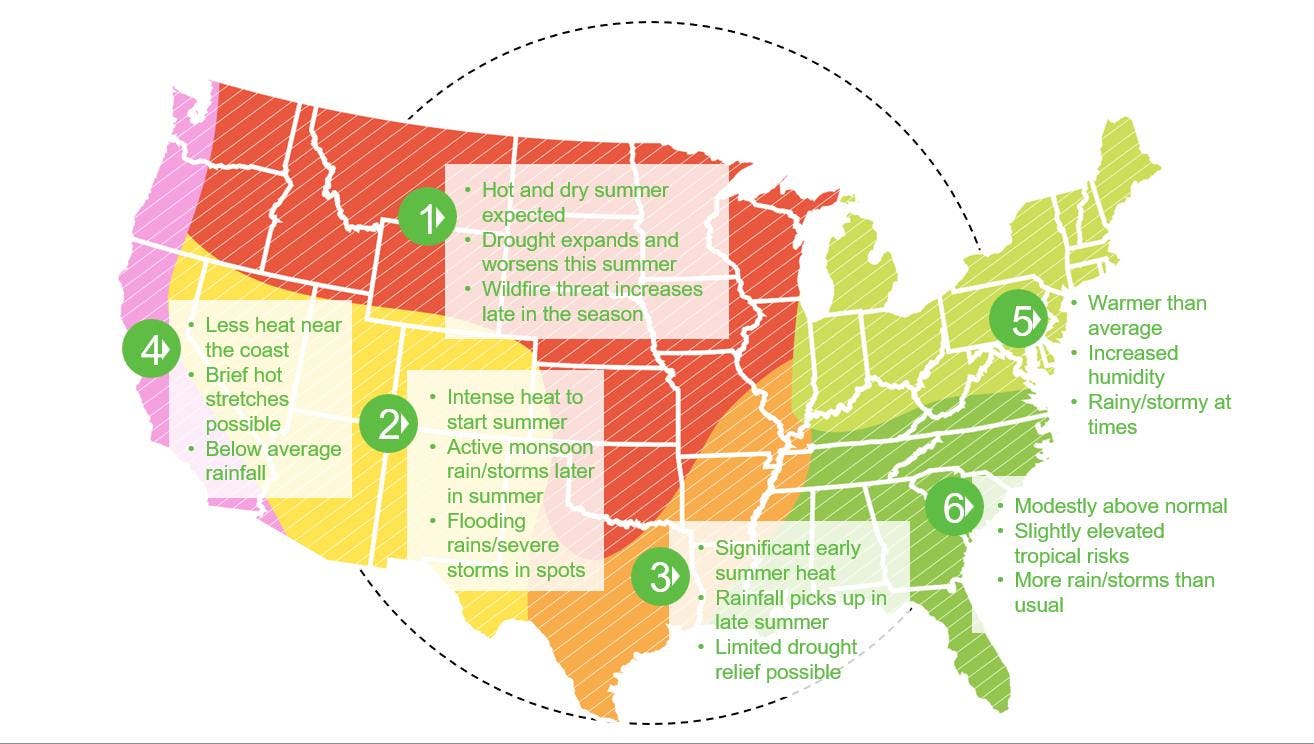Long-range forecasting is growing in importance and accuracy. Using seasonal forecasts like this … More
With the rapid advancement of AI-powered forecasting models like NVIDIA FourCastNet, which can generate a weeklong forecast in less than two seconds, decision-makers are now leaning on weather outlooks up to 14 days in advance. This shift isn’t about trying to predict the unpredictable. It’s about managing risk in a world where the cost of being unprepared has skyrocketed. From supply chain disruptions and staffing limitations to the growing intensity of weather events, the modern operational landscape has created a new dependency on long-range weather intelligence. But this change also introduces new challenges, as longer-range forecasts inherently carry more uncertainty. So how do stakeholders strike the right balance?
What Is Driving Earlier Weather Decisions
One of the most immediate drivers is staffing and labor constraints. With widespread shortages across aviation, utilities, logistics and public works, many organizations are forced to finalize staffing schedules farther in advance. Waiting until a short-term forecast achieves higher confidence can be too late to mobilize a full response.
Global supply chains and logistics dependencies add further complexity. Moving equipment, materials or personnel often requires significant lead time. For instance, utility companies may need to stage storm response crews across state lines or secure fuel for backup generators — actions that can’t wait for last-minute confirmation.
At the same time, extreme weather events are becoming both more frequent and more costly. In the United States, the National Oceanic and Atmospheric Administration reported 27 separate billion-dollar weather and climate disasters in 2024, marking the second-highest annual total on record. With rising volatility and intensity of these storms, the margin for error is shrinking. Even a low-confidence signal in a long-range forecast may now justify activating initial response plans.
Finally, there’s the human factor. Social media and public scrutiny have raised expectations for early, proactive communication. Municipal leaders and business owners face reputational risks if they appear unprepared, especially in the aftermath of a disruptive storm.
Forecast Improvements Are Meeting the Moment
The good news is that long-range forecasts are far more accurate and useful today than they were even a decade or two ago. A 7-day forecast today is roughly 25% more accurate than it was in 2000, and a 10-day forecast is about 45% more accurate, according to ECMWF data verification data. These gains mean that forecasts once considered speculative now offer enough reliability to guide real-world planning and risk mitigation.
Analyzing data from multiple weather agencies, including NOAA, NCAR, AMS and the ECMWF, indicates … More
To meet these evolving demands, many organizations are turning to advanced decision support systems rather than relying on consumer-grade forecasts. These platforms integrate long-range model data, expert meteorologist interpretation and tailored insights specific to each operation’s needs.
In aviation, for example, some airports partner with specialized weather services that provide 10–15 day trend analysis for snow, wind or thunderstorms. This allows teams to preposition deicing equipment or adjust runway maintenance schedules well in advance. Similarly, utility companies rely on ensemble forecasts to assess the likelihood of high wind days, guiding mutual aid agreements and field crew rotations.
Decisions Before Certainty Arrives
Even with the increases in accuracy, the core challenge of utilizing long-range forecasting is the trade-off between early decisions and uncertain data. Yet many critical decisions must be made well before that window closes.
This forces organizations to operate in a gray area, weighing probabilities and trends rather than waiting for definitive outcomes. Consider an outdoor event planner who sees a signal for heavy rain nine days out. Canceling too early could lead to unnecessary financial losses and disappointed attendees. Waiting too long may compromise safety. In these cases, the decision is less about exact rainfall totals and more about risk tolerance, contingency options and operational flexibility.
Organizations that excel in this space don’t wait for certainty. Instead, they treat long-range forecasts as planning tools to build flexible, tiered response plans. This might include staging resources, briefing internal teams, or outlining thresholds for escalation if the threat persists. The key is embracing uncertainty as part of the process, not a barrier to action.
Forecasting The Future
Long-range forecasting will only grow in importance as weather becomes more extreme and operational flexibility more constrained. But this evolution isn’t only about advancing scientific capability, it’s also about reshaping how organizations use forecasts.
Meteorologists are increasingly taking on the role of risk communicators, helping decision-makers interpret long-range signals through the lens of operational impact. I have written about this topic several times in the past, including a recent Forbes article on how AI enhances the role of risk communicators.
The key question is no longer around how many inches it will rain, but rather if the rain amount exceeds a threshold that requires action. Similarly, it’s not just about predicting wind, but understanding whether gusts could damage infrastructure or tents, and how much lead time is needed to adjust staffing, relocate assets or modify logistics.
Looking ahead, more organizations may adopt scenario-based planning, where forecast guidance informs a range of actions depending on confidence levels. This approach helps break free from the binary trap of “go/no-go” decisions and supports a more flexible strategy — one that aligns with how modern weather risks are unfolding.
In a world of growing complexity, organizations must plan further ahead, even if the view is a little fuzzier. By embracing probabilistic thinking, investing in customized weather intelligence and building operational agility, businesses and communities can stay one step ahead of what’s coming. In high stakes situations with little time to spare, acting early even if imperfect is usually better than waiting too long.








